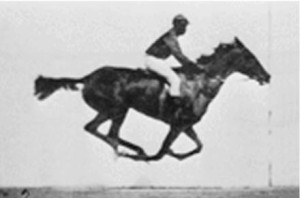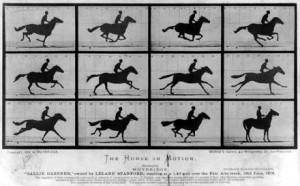Learning Objectives-
1. We will learn about the history of the motion picture film and how it relates to the modern filmmaking
2. We will learn about how modern non-linear editing is based on the model of traditional film editing
3. We will learn the interface of Adobe Premiere Pro CC
4. We will learn how to perform basic edits and the joining of multiple clips in Premiere
We will start by watching a short clip-
- Leland Stanford was the eighth governor of California
- In 1872 Stanford hired Edweard Muybridge to prove whether horses “Flew”. Whether or not all four hooves left the ground when they were in full gallop.
- No one could be sure because photographic technology was still in its infancy and exposures took up to a minute
- Stanford believed that horses in deed did leave the ground and legend has it he bet $25,000 dollars to prove it. That’s around half a million dollars by todays standards.
- Stanford hired Muybridge to prove whether a horse did indeed “Fly” through the air
- Muybridge built an elaborate camera system with fast shutter speeds and trip wires that the horse would ride through to set off.
- Muybridges pioneering efforts paid off. Stanford spent in total over $50,000 on the effort, which led to motion picture film.
After Muybridge made the initial bridge between still photography and motion, the inevitable move to a motion picture was born. In 1895 the Lumiere brothers help the first public screening of a series of short films, including “Train arriving at the Station”. Although Thomas Edison was simultaneously working on motion picture film it is the Lumiere brothers who are credited with being the first to the public square. They took motion, viewed as individual still images, and captured those still images in succession on motion picture film. the film was born, now they needed to edit it.
So Film, motion, from Muybridge to spielberg, from motion studies to film, to full digital incarnations, its all just still images, its all the persistence of vision.
Persistence of vision is the commonly used term to describe the optical illusion whereby multiple discrete images blend into a single image in the human mind and believed to be the explanation for motion perception in cinema and animated films.
So motion, film, it is a series of still images, we call these images frames.
Now I would like to invite you to come over and check out the motion picture film here on the light table.
Now lets look at this same digital film in premiere.
Adobe Premiere Pro CC -Notes


